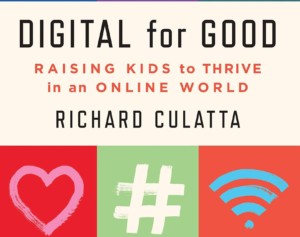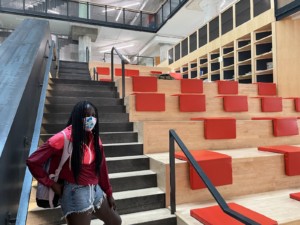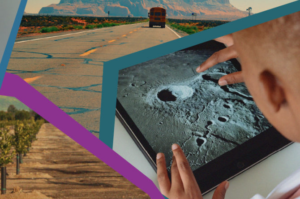Review | Digital Citizenship in Action

 In celebration of the final day of Digital Citizenship Week 2017, and even more so, as an opportunity to kick-start continued conversation around the topic, I’m was gifted with an opportunity to review Digital Citizenship in Action by Dr. Kristen Mattson. This ISTE-published text is an exciting, fun and well-designed resource on the relevant topic of delivering digital citizenship to students. With passion and investment in exploration of the topic, Mattson provides what I have labeled a “handbook” for any educators who have a responsibility or desire to develop digital citizenship within their students, classrooms, libraries, schools or any format of learning opportunity.
In celebration of the final day of Digital Citizenship Week 2017, and even more so, as an opportunity to kick-start continued conversation around the topic, I’m was gifted with an opportunity to review Digital Citizenship in Action by Dr. Kristen Mattson. This ISTE-published text is an exciting, fun and well-designed resource on the relevant topic of delivering digital citizenship to students. With passion and investment in exploration of the topic, Mattson provides what I have labeled a “handbook” for any educators who have a responsibility or desire to develop digital citizenship within their students, classrooms, libraries, schools or any format of learning opportunity.
Chapter 1: Creating Space for Digital Citizenship
Chapter 2: Acknowledging Student Voice in Digital Spaces
Chapter 3: Helping Students Understand Their Roles in Digital Communities
Chapter 4: Participating Through Respectful Discourse
Chapter 5: Networking to Make Meaningful Connections
Chapter 6: Making Contributions That Matter
As Dr. Mattson begins her portrait of the “why, how and what” of digital citizenship, she frames our students, teachers, parents and communities’ journey with a vivid description of the worlds that we live in. She describes the worlds of “Real Life (RL),” Immersive Reality (IR),” and (my favorite), “the world of imagination,” where “we can dream boldly about how to integrate RL and IR, and how to shape the endless possibilities that living a digital lifestyle presents us.” She continues to support retention through defining various aspects of the process with emphasis on current approaches and a thorough description of her definition and belief of a participatory citizenship approach.
Her connections are evident through the lessons she provides via her lens as a current practitioner who is serving students as they navigate their progression as digital citizens. Her approach (and the overall presentation of the book) is framed in a way that provides the opportunity for immediate implementation, and is extremely successful in identifying barriers, with solutions for accelerating the integration of digital citizenship.
Each chapter is extremely user-centered with a consistent flow throughout the 6 chapters, enhanced by a logical progression that scaffolds the lessons provided. As outlined in the chapter index, Mattson does an excellent job of supporting the assessment of readiness through a student survey (all questions provided) in the areas of access, activity and skill. This personalized beginning reinforces a theme of differentiated starting points and uniqueness within each environment, while still being anchored to a common goal of supporting the growth of the whole. The exciting aspect of this foundation lies in capturing relevance for each and every student (and teacher, if they have hesitation based on new territory), regardless of where they currently reside on the digital citizenship continuum.
As I continued my journey, I was impressed with the seamless titling and the depth associated with each chapter. In chapter two, Acknowledging Student Voice in Digital Citizenship, Mattson provides us with arguably the most important factor in developing sustainable digital citizens, which lies in empowering student voice in the creation of a digital learning community. Without spoiling the setup, this real-life, author-lived scenario provided a very relevant, and in this scenario, personal approach to supporting your own reflections as you prepare the teaching environment. Mattson illustrates a conversation that included social media, her mom and the 2016 election, and while these ingredients could potentially lead to a disastrous conclusion, her articulation of the scenario and reflective outcome delivered an excellent affirmation of the importance of successfully establishing student outlets that enable them to share their views on the creation of student-owned responsibilities within the learning environment.
“Have we given our students the tools to shape their own digital communities in ways that are reasonable, empowering and valid?”
Digital Citizenship in Action continues to follow an identical format for each chapter, much like Leading Personalized and Digital Learning, which increased comprehension. Prior to reading the next chapter, my confidence regarding depth and quality of content grew. The progression was also intentional in providing fluidity of connecting the chapter headings as a build of implementation-ready knowledge, including personalization in the form of “Spotlight Story and You Can Do It.” Each chapter concludes with inspiration and encouragement for a teacher as they continue to design their strategic rollout or expansion of access and opportunity for students to embrace digital citizenship. They are appropriately titled, “You Can Do It!” and serve as an anxiety-reducing “glass half full” summary of the chapter, with just enough reflection to help educators own the content. Chapter two concludes with a skillful transition into the next chapter and with a legitimately thought-provoking cliffhanger that fueled my desire to reflect en route to the next chapter.
“For far too long, adults have talked about digital citizenship as a list of rules for students to follow. I propose that we expand our conceptual understanding of the term and begin thinking about well-rounded digital citizens as an outcome goal of a future-ready education.”
This book is one of the most thorough and user-friendly digital citizenship guides I have read in quite some time, and I would recommend it for educators at various places along the digital citizenship continuum. Whether novice in your experiences or taking it to the next level of reflection and refinement, Digital Citizenship in Action will be a value add.
For more, see:
- Supporting Digital Citizenship Development as a School Counselor
- Smart Review | Leading Personalized and Digital Learning
- How Digital Literacy Impacts Today’s Classroom
Stay in-the-know with all things EdTech and innovations in learning by signing up to receive the weekly Smart Update.








0 Comments
Leave a Comment
Your email address will not be published. All fields are required.